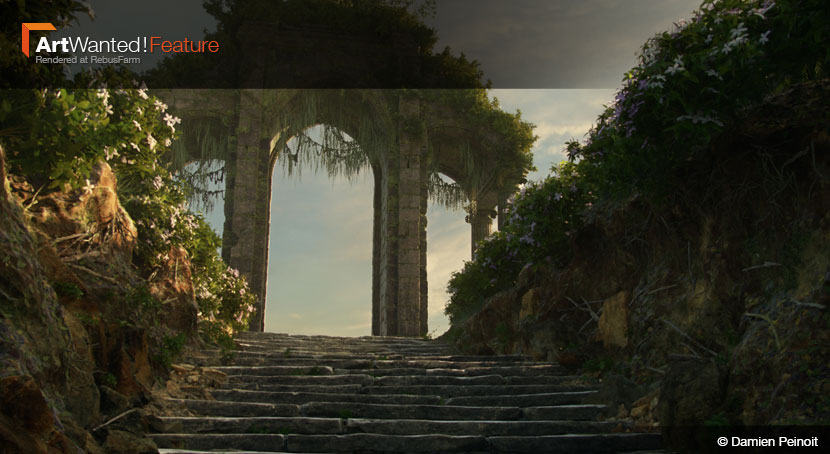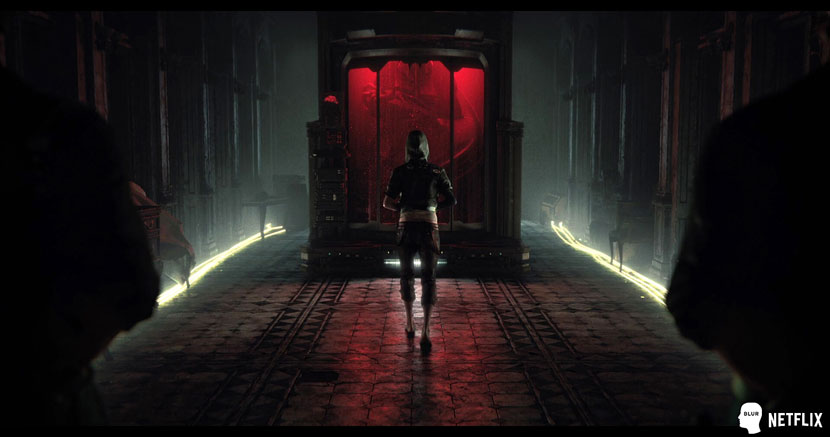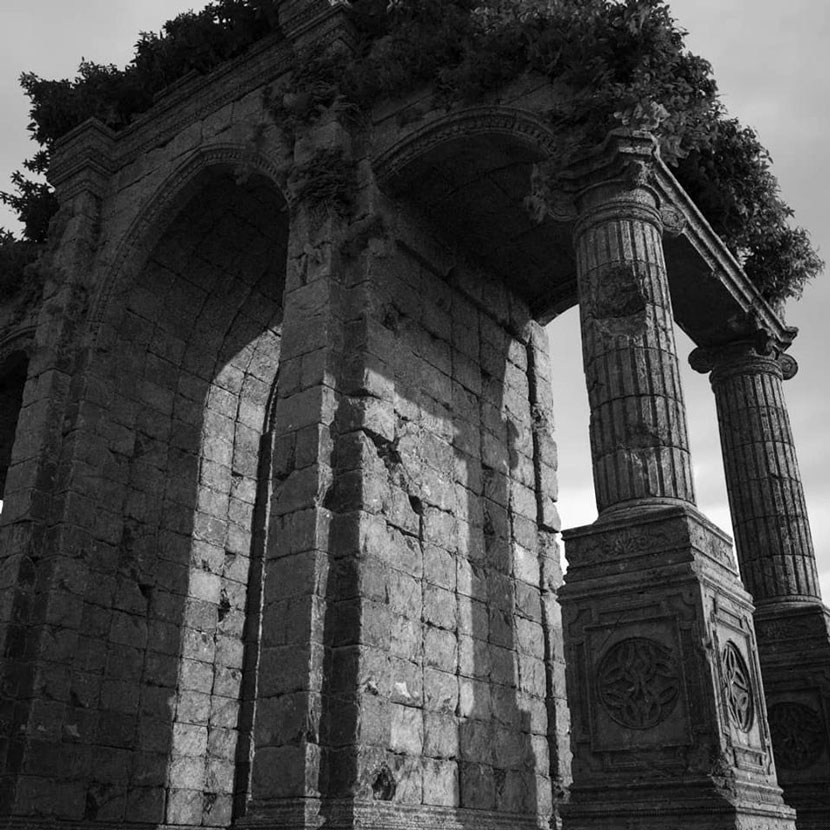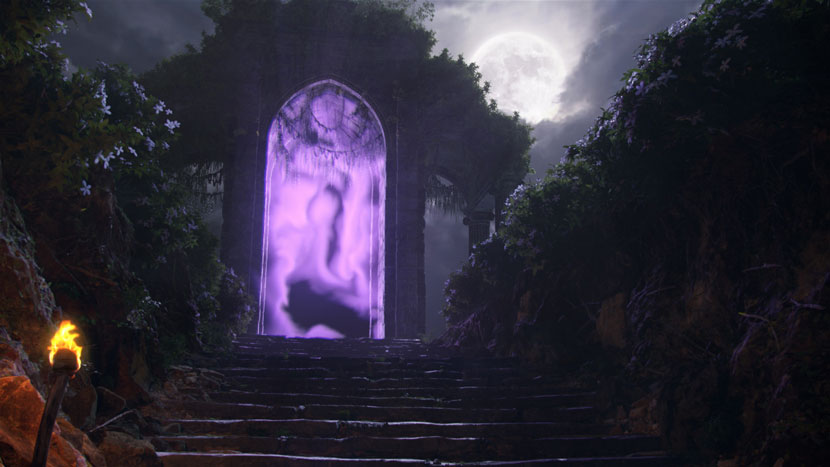Monday, November 18th, 2019 by Julian Karsunky

If you have been to the movies lately or are an avid gamer, there’s a significant chance you encountered the work of Damien Peinoit. The French CG generalist is an accomplished industry veteran and has been involved in blockbuster productions such as ‘Aquaman’, ‘Detective Pikachu’, ‘Division’ and the ‘Halo’ franchise. Driven by his passion for environments and VFX, Damien has recently started creating online tutorials as well, sharing his insight with the recently released ‘Masterclass I’ course.
In our interview, Damien recalls climbing the ranks as an ambitious artist, discusses his approach to teaching and shares valuable tips with our readers.
Hi Damien, thanks for joining us! To start things off, please introduce yourself to our readers!
Hello, my name is Damien Peinoit, I’m a 37-year-old 3D generalist from France, specializing in the creation of full CG environments for VFX and game cinematics.
What initially led to you pursuing a professional career in the CG industry?
Like so many of my colleagues, I first became interested in this industry because of gaming, with Diablo II being my personal gateway. The cinematics in that game impressed me so much that I immediately knew: this is what I want to do! First, I started out learning myself, I remember messing around with the Duke Nukem level creator just for fun; later, I decided to join a school and get a proper diploma. Afterwards, I began working for game and advertising studios while steadily developing my personal portfolio on the side. This eventually led to opportunities to work on AAA game trailers and cinematics.
With over 14 years of experience as a CG artist, you have enjoyed quite an illustrious career! What are some of your personal highlights thus far?
Well, I have always been especially fond of environments, so once I became fully dedicated to that, I was fortunate enough to work on game cinematics and movies such as ‘Love Death and Robots’, ‘Aquaman’, ‘Halo’, the ‘Division’ trailer, and more! So, it’s not easy to pick favorites, but I’ll try.
One of the highlights of my career was when I first started working for Blur. What I thought to be an ordinary test, actually turned out to be an environment for a trailer for ‘Dark Souls 2’!
More on the personal side, in 2014 my friends and I got together and created a ‘Tales from the Crypt’ fan art short film. This project taught me a lot about the overall work and structure of animated films and, as part of my portfolio, made a huge difference when speaking to ILM, which is where I’m currently working.
I think artists should never underestimate the importance of personal work and I encourage everyone to keep producing. Not only does it improve your general workflow, but, more importantly, it shows recruiters your real potential and capabilities!
Let’s take a step back and take a closer look at the beginning of your career. After first experiences as a 3D generalist in the video game industry, you decided to further hone your skills, move to Paris and focus on freelance work.
Right, after two and a half years working for a video game company, I moved to Paris in search of more and better opportunities. There, I worked at an advertising studio for a while. I moved to Paris to get access to more opportunities. My long-term goal had always been to be independent and have my own business, so I eventually quit employment and started freelancing full-time.
Was working for high-profile studios or within a specific industry part of your plan?
Well, I always liked creating environments, so I was happy as long as I got to do just that, even if it was for a fragrance commercial. Although, once I caught a whiff working on the ‘ZombieU’ trailer, I started to aim for cinematic studios. After all, it’s more fun to do an apocalyptic street than a fragrance commercial, isn’t it? But still, I had to work up to that. I think the key was that I never gave up and I kept improving, so that once given the opportunity, I would be ready to do the work I was passionate about.
Having extensive experience both with freelance work and employment, what are the main benefits and challenges of each? Do you enjoy one over the other?
I will never complain about working in a company environment; I met a lot of very talented and nice people, many of whom have become close friends over the years. Plus, I like exchanging ideas with co-workers and asking for advice, that’s what makes us grow as artists. At Blur or ILM, for instance, there’s such an abundance of concentrated talent, you can’t help but improve.
Freelancing, on the other hand, I enjoy quite a lot. Having your own schedule, working in your personal space, the taste of freedom – that’s all great. But, surprisingly enough, I found out that I’m more productive freelancing than being staff. It’s probably because I’m able to focus more without being distracted as compared to, say, working in a giant open space?! Though the biggest benefit to me is when working overtime, being in your own office is way less stressful than being far away from home. The downside would be that you are alone most of the time, with no co-workers around and I know a lot of people don’t like that. I’d say if you are fine with that, go for it!
 The Netflix series ‘Love, Death and Robots’ is just one of many high-profile projects Damien has been involved in.
The Netflix series ‘Love, Death and Robots’ is just one of many high-profile projects Damien has been involved in.
Can you explain your passion for environments? What skills does a good environment artist need and how did you acquire them?
Hard to say, I just always liked drawing landscapes or taking pictures, so it just made sense I would specialize in that, you know? I worked in commercials for a very long time, and while you unfortunately don’t really develop specific skills, you do become an efficient generalist. I had to learn how to be fast and also to be resourceful, because most of the time you have to tackle a project on your own, especially when freelancing.
The most important things, I would say, are composition, a sense for scale, and being a good problem solver. Environment artists are an integral part of the development process, since we’re dealing with so many assets at once. If anything goes wrong, you have to be able to fix it quickly.
Is there a specific design philosophy you adhere to? What inspires you as a 3D artist?
From lighting, to colors, sets and even storytelling, movies make up about 80% of my inspiration. When I create environments, I like to come up with a story first, even if it’s just in my head: why and when has this world been destroyed, by what or by who? How is the weather in this area, is it cold and humid? Warm and dry? The answer to all of those questions will shape and impact on the final image, so it is an important part of the process and helps make environments look and feel more realistic. Everything has to have a purpose!
Also, I love playing with contrast! You might’ve noticed that most of my pictures are rather dark, that’s because I love moody lighting, even if it means the modeling is barely visible.
Detective Pikachu, Aquaman, Halo and Dark Souls - what is it like working on blockbuster movies and AAA games of this caliber? Can you still enjoy the final product regardless of your involvement or do you always watch from a technical standpoint as well?
As an artist, it’s hard to be completely happy with the result of my own work. It’s tough to not notice where you could’ve done better. But still, I am very passionate about CG and I can talk about environments for hours. I wish everyone got the chance to work on big AAA games trailers or movies, it’s always better to leave your comfort zone, learn new techniques and challenge yourself.
What are the most common misconceptions people have about your work?
Nowadays, there aren’t many misconceptions about my work anymore, but when I started, people always thought that, as a generalist, I was able to do characters and rigging as well. That being said, you still have to know tons of things and that can drive you crazy, especially when you have to switch between tools and shortcuts.
 The arch is the central asset of Damien’s most recent online tutorial.
The arch is the central asset of Damien’s most recent online tutorial.
In addition to your contract and freelance work, you recently became invested in online tutorials. Tell us all about DamSchool, please!
I started DamSchool because I really enjoyed the opportunities I had at teaching for different schools as an external speaker, it was a fun experience! The goal is to keep producing online courses, and to help people improve their CG skills as much as possible. Initially, it was just for fun, but as I love making tutorials, I now want it to become bigger. Though I’m not saying it’s going to turn into a full school, since I’m working both a full-time job as well as on personal stuff on the side. But I certainly wouldn’t mind giving it more time. There is no urgency anyway, because I really aim for quality courses, which can take time to produce.
Let’s talk about your most recent tutorial, the Masterclass I, a comprehensive online guide to cinematic environments and VFX. Consisting of 16 hours of video footage, can you breakdown the content and structure of the course for us?
In this course, you will be taught how to create a list of reusable assets and finalize the lookdev you’re trying to achieve. I divided this course into five chapters: modeling and sculpting, assembly, detailing and scattering, rendering, and the FX. For tighter budgets, these lessons can be purchased individually, although the FX one is only included for free with the full pack.
My goal was to release an online course that covers all aspects of photorealistic environments without the use of scans. I wanted to make it quick and easy, you will have access to streaming videos at any time to help you learn at your own pace! With regards to software, I mostly cover ZBrush, 3ds Max, V-Ray, Speedtree, and Forest Pack.
How long did it take you to complete the ‘Masterclass I’?
Overall, I spent about two weeks working on it, but subtitling the lessons in French and English took a lot longer! For the next one, I will probably proceed differently.
How much did your personal experience as a student and self-taught artist influence and shape this tutorial?
I purchased some tutorials and occasionally, I was a bit disappointed because even if the content was good, some were way too long! Personally, I found it hard to follow 80 hours of tutorials and ended up looking elsewhere most of the time. That’s why I aimed for a shorter format because this is what I like myself: straight forward and to the point, no detours!
The main challenge was to keep a high level of quality throughout shorter videos. It’s a good test to see the response, for now people seem to be very happy with it!
Did you already devise a curriculum past the first Masterclass? When can we expect a second lesson?
I’m working on other tutorials right now, but as I already mentioned, I just recently changed my workflow. I decided to try using Blender and Unreal Engine together to achieve VFX or cinematic quality. It’s a lot of experimenting, but I want to find a way to implement this new pipeline into my upcoming tutorials. So please be patient, in the meantime I am still working on free tips and tricks and other content!
Please tell us about the DamSchool mentorship program you are working on!
Hopefully, it will be ready soon! The idea is to build up a small mentorship program first, and see how it goes. If things work out well, I then want to expand and do real tutoring with four to six weeks of advanced generalist classes.
I will probably start by having two or three hours of tutoring a week, covering everything related to a generalist’s position. Coming soon!
As a small appetizer, what basic, yet not-obvious tip would you give aspiring environment artists?
When it comes to environment creation, blocking and layout are some of the most important aspects! It will help you build the scale, the compositing and also the lighting. I usually work on both at the same time: basic modeling, such as rough boxes and simple shapes, and lighting. Working both simultaneously helps me seeing where I can add details and where I can save time. Always start with nice blocking, because it will be there from start to finish.
Also, competition has become quite fierce in our industry, so I generally recommend to keep practicing and being curious about new software and technology! It will be rewarding in the long run, trust me.
 This moody nighttime version of the scene was an on-the-fly addition to Damien’s Masterclass tutorial.
This moody nighttime version of the scene was an on-the-fly addition to Damien’s Masterclass tutorial.
We are thrilled to be an official partner of the Masterclass series! Can you tell us about the importance of cloud rendering in terms of the course as well as your work in general? Is there anything you particularly like about our services?
I used to work locally with a French render service, but eventually decided to look for online solutions. I wanted something equally accessible, when a friend recommended your website. Thanks to RebusFarm, I was able to render an additional version of my scene: originally, I only planned for the daytime version, but was able to complete the night scene as well! I got everything done in just a few hours, which saved me time to work on other parts of my tutorial.
I definitely recommend your services to others, not just because it’s fast, but because of the amazing support you provided when I was having minor issues. I will definitely use your service again for the next Masterclass!
We’re happy to hear this! In closing, is there anything else you want to say? Any present or upcoming projects you’d like to mention, say, the project you’re working on at ILM right now?
Unfortunately, what happens at ILM stays at ILM, sorry. :)
First, I want to thank you guys for this interview and sharing some of my work! Also, thank you to everybody reading this as well, I hope you enjoyed it as much as I enjoyed answering these questions!
Last, but not least, I’m really excited to welcome Blender and Unreal to my workflow and look forward to share more content real soon. Please stay tuned for new tips and new tutorials!
We can hardly wait! Damien, thank you very much for taking the time and all the best in the future!
Keep up with Damien Peinoit and his work here:
How to join ArtWanted!
You want to get featured in our ArtWanted! campaign and win 250 RenderPoints on top? Submit your work, rendered at RebusFarm, to Cette adresse e-mail est protégée contre les robots spammeurs. Vous devez activer le JavaScript pour la visualiser.! Visit our Art Wanted! page for more information.
>> Read more articles on our blog
